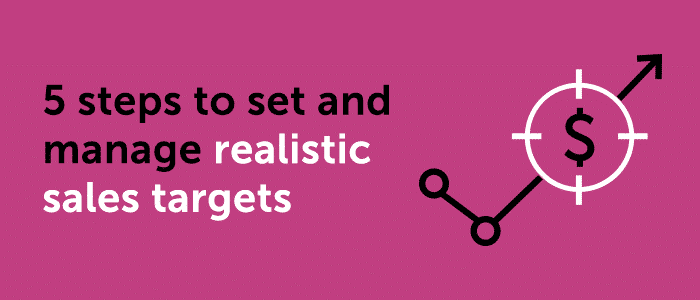How to set realistic sales targets and manage them effectively

Use these five key considerations for setting sales targets that increase your chances of achieving your business goals.
Many businesses often fail when it comes to setting sales targets. A common strategy is to simply look at the previous year’s revenue and add what appears to be a reasonable rate of growth. However, this approach does not take into account any changing variables, such as market volatility, a new product line, or expanding into a new geography. As a result, it can lead to unreasonable, unattainable figures.
Setting unrealistic or inaccurate sales targets can have a major impact on business outcomes. If targets are set too high, you’ll drive costly attrition. If targets are set too low, you’ll overpay for the same performance. Not only can it affect cash flow management, but it can also erode management’s credibility and sales motivation, either because targets are consistently underachieved or too easily overachieved.
To accurately set sales targets, organizations need a platform that rolls a sales forecast info a revenue forecast, taking into account past performance, account value, rep performance, and foresights based on business goals. A platform that connects plans and data across the business can empower organizations to achieve an accurate forecast and more attainable sales goals.
Five considerations for your sales targets
With Anaplan — a platform that can accommodate past, current and, most importantly, forward-looking data — your sales team is better armed to meet and exceed their goals. You can also streamline top-down quota-setting, bottom-up quota setting, or take a hybrid approach.
Now consider the following five factors to set more realistic sales targets:
Business situation: Every business is different, and that’s why it’s important to start by considering which factors affect your revenue quarter-by-quarter. Is your business seasonal? Do you have a strong recurring revenue stream? Is your business contract-driven? Does your business have high cogs or high margins? To create a more accurate sales forecast that’s tailored to your business, consider all these factors, along with the life cycle of your product or service portfolio.
Economic factors: What is happening in your industry and within the wider economy that could have an impact on revenue? Do you operate in volatile markets? Are you in a highly competitive industry? Be as thorough as possible in your evaluation of the variables that may affect either your revenue or the performance of your sales reps.
Revenue per rep: Take a look at what each rep generated in the previous year and years prior. Collect customer share of wallet for their accounts, which may be indicative of future potential. This is where a thorough account segmentation and scoring process is extremely valuable, as it can greatly impact the targets and sales incentives you should set for your team.
Solicit feedback: It is important that you solicit feedback — before and during the sales forecasting and target-setting process. As your frontline employees, sales reps may provide objections or highlight variables that you have not considered. They can at times tell you more than the numbers can — for example, industries that may be very hard to break into or regions where your product’s value proposition is not working. Using intent data can uncover the actual revenue potential of an account. This type of crucial field insight can change the breakdown of the sales forecast and targets into something more attainable and realistic.
Implement a rolling forecast: Despite the well-documented advantages of a rolling forecast, most companies still conduct traditional forecasting based on a preset annual or quarterly schedule. This approach turns the forecasting process into one of performance evaluation, as opposed to elevating the opportunities and risks ahead — leading to a loss in forward visibility. To overcome this disadvantage, consider implementing rolling forecasts with consistent periods within each forecast window. No economy, market, or customer organization is static, so your sales forecast shouldn’t be either.
If your revenue expectations are not in tandem with what you can reasonably expect from your sales force, you will see a ripple effect on business revenue, employee engagement, and turnover. Don’t risk this — see how the Anaplan platform can transform your business and improve your sales performance management by enabling better-informed decisions and more realistic sales targets.


